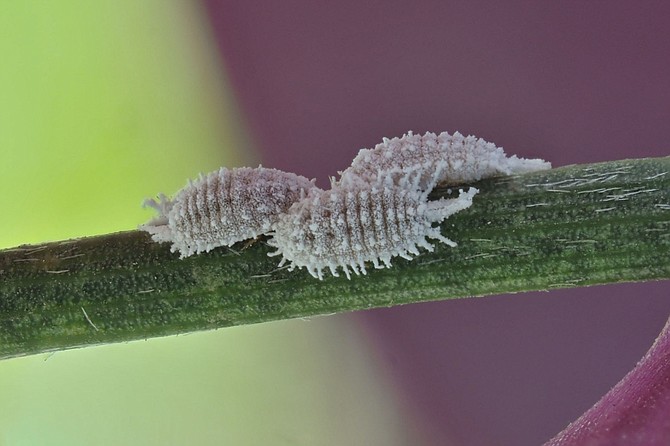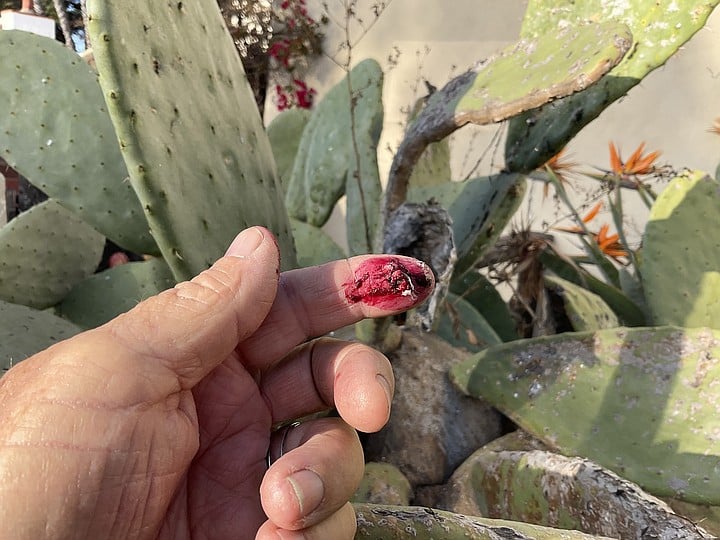 Facebook
Facebook
 X
X
 Instagram
Instagram
 TikTok
TikTok
 Youtube
Youtube

Tuna found in the desert? OK, fair enough: that’s tuna, as in the Spanish for prickly pear, the fruit of the nopal. Ken Factor and I have spotted an ancient cactus tree growing close to the veranda outside the visitors’ center here in Old Town plaza. Their natural habitat, of course, is out where you’d find Pecos Bill: in places like the Anza Borrego.
“These are beautiful,” I say to Factor, one of the State Park staffers. Indeed, the tuna are red, luscious-looking fruits, bursting through the green skins of the cactus paddles.
“Yes, but if you’re looking for real treasure,” says Factor, “you should look at the white fuzzy stuff between the tuna. Kings and princes fought wars for these little things.”
Now Ken mentions it, I do notice the tiny webs growing on most of each of the cactus’ paddles. “Why so valuable?” I ask.
“Watch this,” Ken says. He leans forward, and with his finger and thumb, picks up one of the white smudges. He squashes it. It turns instantly scarlet.
“Blood? Did you prick yourself?” I ask.
“Not my blood. It’s the liquid that this little creature spurts out to damage anything trying to eat it. It was a sensational red dye discovery. Like the tulips of Holland, it was suddenly the thing. In dull 1600s Europe, this electric red came out of nowhere.”
“Was it the only red dye around?”

“Well, yes, it was. It was roughly ten times more intense than any red dye known to humankind. Ten times as red! It had always been around. Native American chiefs used it to color their robes.” In Mexico, it seems, around centers like Oaxaca, the Aztec workers spent their days using lopped-off deer tails to wipe the cochineal scale off cactus paddles while avoiding the cactus spines. And when the Spanish came, the conquistadors started sending shiploads of it back to their kings, to give them the brightest robes — and, among their elite troops, the most fearsome scarlet uniforms. The Spanish ruled this trade — and kept the secret of what the dye was and where it came from — for centuries. Everybody craved it. Think of the British Redcoats. Only officers could dye their jackets with cochineal.
“Remember,” says Factor, “Europe was a brown and green world. They had never seen anything this spectacular.” Self-respecting monarchs, he says, could not afford to be seen in anything less. The price of “cactus blood” skyrocketed. Fortunes were made. Cochineal became Mexico’s biggest export after silver. Factor rubs his red-stained finger against his thumb. “And all from this little parasite that likes to drink cactus sap.”
So why don’t we hear about this miracle bug any more? “Cheap synthetic pigments and dyes came along in the late 19th, early 20th centuries. They just about killed off cochineal.” But not quite. Recent concern that some commercial synthetic red dyes and food colorings may be carcinogenic have spurred a rethink of cochineal, which has been found to be neither carcinogenic nor toxic — and so okay to use as a beauty colorant.
“I was leading a tour around Old Town,” says Factor, “and one of the older ladies stopped. She squished a cochineal growth, then proceeded to slowly smear it across her lips, like lipstick. ‘I am Mexican,’ she told me. ‘This is what we have always used it for.’ Maybe she’s ahead of the next wave of natural beauty products.”


Tuna found in the desert? OK, fair enough: that’s tuna, as in the Spanish for prickly pear, the fruit of the nopal. Ken Factor and I have spotted an ancient cactus tree growing close to the veranda outside the visitors’ center here in Old Town plaza. Their natural habitat, of course, is out where you’d find Pecos Bill: in places like the Anza Borrego.
“These are beautiful,” I say to Factor, one of the State Park staffers. Indeed, the tuna are red, luscious-looking fruits, bursting through the green skins of the cactus paddles.
“Yes, but if you’re looking for real treasure,” says Factor, “you should look at the white fuzzy stuff between the tuna. Kings and princes fought wars for these little things.”
Now Ken mentions it, I do notice the tiny webs growing on most of each of the cactus’ paddles. “Why so valuable?” I ask.
“Watch this,” Ken says. He leans forward, and with his finger and thumb, picks up one of the white smudges. He squashes it. It turns instantly scarlet.
“Blood? Did you prick yourself?” I ask.
“Not my blood. It’s the liquid that this little creature spurts out to damage anything trying to eat it. It was a sensational red dye discovery. Like the tulips of Holland, it was suddenly the thing. In dull 1600s Europe, this electric red came out of nowhere.”
“Was it the only red dye around?”

“Well, yes, it was. It was roughly ten times more intense than any red dye known to humankind. Ten times as red! It had always been around. Native American chiefs used it to color their robes.” In Mexico, it seems, around centers like Oaxaca, the Aztec workers spent their days using lopped-off deer tails to wipe the cochineal scale off cactus paddles while avoiding the cactus spines. And when the Spanish came, the conquistadors started sending shiploads of it back to their kings, to give them the brightest robes — and, among their elite troops, the most fearsome scarlet uniforms. The Spanish ruled this trade — and kept the secret of what the dye was and where it came from — for centuries. Everybody craved it. Think of the British Redcoats. Only officers could dye their jackets with cochineal.
“Remember,” says Factor, “Europe was a brown and green world. They had never seen anything this spectacular.” Self-respecting monarchs, he says, could not afford to be seen in anything less. The price of “cactus blood” skyrocketed. Fortunes were made. Cochineal became Mexico’s biggest export after silver. Factor rubs his red-stained finger against his thumb. “And all from this little parasite that likes to drink cactus sap.”
So why don’t we hear about this miracle bug any more? “Cheap synthetic pigments and dyes came along in the late 19th, early 20th centuries. They just about killed off cochineal.” But not quite. Recent concern that some commercial synthetic red dyes and food colorings may be carcinogenic have spurred a rethink of cochineal, which has been found to be neither carcinogenic nor toxic — and so okay to use as a beauty colorant.
“I was leading a tour around Old Town,” says Factor, “and one of the older ladies stopped. She squished a cochineal growth, then proceeded to slowly smear it across her lips, like lipstick. ‘I am Mexican,’ she told me. ‘This is what we have always used it for.’ Maybe she’s ahead of the next wave of natural beauty products.”
Comments